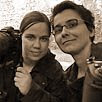
 Our ferry docked in Iceland on the 20th of May. I was sent here to take pictures of colony-nesting seabirds (puffin, razorbill, guillemot etc.), skuas, waders, harlequin duck, gyrfalcon, arctic fox, in addition to the landscapes of volcanic Iceland (geysers, steam vents), a series of waterfalls and glaciers. A very ambitious goal for a two week mission. I feel a little more comfortable after deciding to spend 3 months on the island. This is also for our own purpose, as my husband, Erlend Haarberg, came with me on the trip.
Our ferry docked in Iceland on the 20th of May. I was sent here to take pictures of colony-nesting seabirds (puffin, razorbill, guillemot etc.), skuas, waders, harlequin duck, gyrfalcon, arctic fox, in addition to the landscapes of volcanic Iceland (geysers, steam vents), a series of waterfalls and glaciers. A very ambitious goal for a two week mission. I feel a little more comfortable after deciding to spend 3 months on the island. This is also for our own purpose, as my husband, Erlend Haarberg, came with me on the trip. When I arrived in Iceland, nature was just awakening from its long winter dormancy. Though the trees had no leaves yet and the landscape was a dull brown, many signs told you about the oncoming summer. The migrating birds had arrived, some were already playing on the nesting grounds, others waiting on mountain heaths and agricultural fields, for the retreating of the ice at higher elevations. Thousands of pairs of greylag geese, pink-footed geese and whooper swans could be seen along the roads, ready for the highlight of the year, the rearing of the new generation.
 My first destination was Myvatn, where the last sheets of ice retreated right before my arrival, and was occupied by thousands of ducks. The name of the lake has the answer why they are all here.
My first destination was Myvatn, where the last sheets of ice retreated right before my arrival, and was occupied by thousands of ducks. The name of the lake has the answer why they are all here.
It is called “Midge water” for the billions of insects (midges and black flies) that are invading the lake and the surrounding area at the start of the vegetation period.
 I was lucky to see (and unlucky to feel on my skin) the swarming of these insects that – according to the researchers – was the best in 2008 out of ten years.
I was lucky to see (and unlucky to feel on my skin) the swarming of these insects that – according to the researchers – was the best in 2008 out of ten years.
 I have never been to Iceland before, so I asked for the help of an Icelandic nature photographer, Daniel Bergmann, about the best places to visit. At lake Myvatn I met him personally. After he showed me around the lake, I jumped straight into work. I had some nice days during the first two weeks which I used for bird photography from different hides I set up around the lake.
I have never been to Iceland before, so I asked for the help of an Icelandic nature photographer, Daniel Bergmann, about the best places to visit. At lake Myvatn I met him personally. After he showed me around the lake, I jumped straight into work. I had some nice days during the first two weeks which I used for bird photography from different hides I set up around the lake.
Myvatn is a paradise for bird watchers and photographers, probably one of the best places in Europe to observe ducks. Sometimes quite special ones, like the harlequin duck or the Barrow’s goldeneye that are only breeding on Iceland in Europe. My first interest turned towards the tiny, gaudily patterned species, the charismatic harlequin duck. Compared to other ducks, this species is special for it can be found in rivers with a strong current, diving for food close to rapids and waterfalls.
This was followed by the long-tailed duck, the greater scaup, and the Slavonian grebe, that I was lucky to work with. Only the sometimes miserable weather disappointed my ambitions.

 June 20, 2008
June 20, 2008 It is an experience that I would recommend any person with any interest in nature to do at least once in your life. See the incredibly charismatic eagles sweep down and catch fish just beside the boat, 15 metres away! Along with a great flock of always hungry and wonderfully beautiful gulls of several species.
It is an experience that I would recommend any person with any interest in nature to do at least once in your life. See the incredibly charismatic eagles sweep down and catch fish just beside the boat, 15 metres away! Along with a great flock of always hungry and wonderfully beautiful gulls of several species. On land, the vegetation is bursting out in green and vivid colours from the sunshine 24hrs a day, in this Land of the Midnight sun. Flowers that are veritable gems in the warm evening light. Some of the true Wild Wonders of Europe!
On land, the vegetation is bursting out in green and vivid colours from the sunshine 24hrs a day, in this Land of the Midnight sun. Flowers that are veritable gems in the warm evening light. Some of the true Wild Wonders of Europe!





















